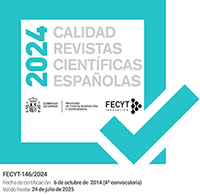El arte del buen morir en los testamentos medievales de la catedral de Sigüenza (siglos XIII-XV)
DOI:
https://doi.org/10.5944/etfiii.29.2016.14046Palabras clave:
Religiosidad, Baja Edad Media, muerte, testamentos, sociedad medieval, Castilla, Religious Belief, Late Middle Ages, Death, Wills, Medieval Society, Castile.Resumen
El presente artículo tiene como objeto contribuir al conocimiento de la religiosidad bajomedieval castellana y dilucidar las actitudes ante la muerte del hombre medieval. Con el propósito de esclarecer la mentalidad de los miembros privilegiados de la sociedad seguntina bajomedieval, tanto de laicos como de eclesiásticos, hemos analizado un grupo de testamentos conservados en el Archivo de la Catedral de Sigüenza de los siglos XIII, XIV y XV. Gracias a estos documentos oficiales podemos acercarnos a las concepciones sobre la vida y la muerte que imperaban en dicho contexto. En los testamentos quedan codificados los ritos y actitudes que el hombre utilizaba para transitar de la vida terrenal al más allá y alcanzar la tan ansiada Salvación Eterna.
This article contributes to the knowledge of Castilian medieval religious belief and to explain the attitudes of medieval man towards death. It aims at shedding light on the mentality of the privileged members of late medieval Sigüenza, both lay and clergymen, by studying a collection of wills preserved in the Sigüenza Cathedral Archive from the thirteenth, fourteenth and fifteenth centuries. Through these official documents we can begin to discern the ideas regarding life and death that prevailed in this context. These wills establish models of rites and attitudes that people adopted in order to go from earthly life to the afterlife and to reach the much-coveted eternal salvation.
Descargas
Descargas
Publicado
Cómo citar
Número
Sección
Licencia
Los autores que publican en esta revista están de acuerdo con los siguientes términos:
- Los autores conservan los derechos de autor (copyright) de las obras publicadas y garantizan a la revista el derecho de ser la primera publicación del trabajo al igual que permiten la reutilización del mismo bajo la licencia de uso indicada en el punto 2.
- Las obras se publican en la edición electrónica de la revista bajo una licencia Creative Commons Reconocimiento-NoComercial 4.0 Internacional, que permite a otros compartir el trabajo con un reconocimiento de la autoría del trabajo y de la publicación inicial en esta revista. Se pueden copiar, usar, difundir, transmitir y exponer públicamente, siempre que: i) se cite la autoría y la fuente original de su publicación (revista, editorial y URL de la obra); ii) no se usen para fines comerciales.
- Se permite y se anima a los autores a difundir electrónicamente las versiones pre-print (versión antes de ser evaluada) y/o post-print (versión evaluada y aceptada para su publicación) de sus obras antes de su publicación, ya que favorece su circulación y difusión más temprana y con ello un posible aumento en su citación y alcance entre la comunidad académica (por ejemplo, en repositorios institucionales o en su propio sitio web). Color RoMEO: verde. (Véase The Effect of Open Access) (en inglés).
Authors who publish in this journal agree to the following terms:
- Authors retain copyright and grant the journal right of the first publication with the work simultaneously licensed under a Attribution-NonCommercial-NoDerivatives 4.0 International, that allows others to share the work with an acknowledgement of the work's authorship and initial publication in this journal.
- Authors are able to enter into separate, additional contractual arrangements for the non-exclusive distribution of the journal's published version of the work (e.g., post it to an institutional repository or publish it in a book), with an acknowledgement of its initial publication in this journal.
- Authors are permitted and encouraged to post their work online (e.g., in institutional repositories or on their website) prior to and during the submission process, as it can lead to productive exchanges, as well as to earlier and greater citation of the published work (See The Effect of Open Access).








